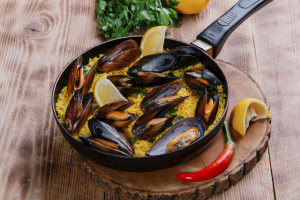Menu
Install the app
How to install the app on iOS
Follow along with the video below to see how to install our site as a web app on your home screen.
Note: This feature may not be available in some browsers.
You are using an out of date browser. It may not display this or other websites correctly.
You should upgrade or use an alternative browser.
You should upgrade or use an alternative browser.
Greek Food, Cooking and Recipe Community
How can I make Greek style mussels?
- Thread starter xmelissaa
- Start date
1 - 6 of 6 Posts
ellinasgolfer0320
Well-known member
You can eat them plain but there are other ways you can do them. If you never know what to do with something, just cook it in tomato sauce (I'm half joking).
Here are a few links You may need to use google translate, but all I did was search "συνταγές με μύδια" (mussels recipes).
Mussels Saganaki
8 Mussels recipes
Mussels with white wine and mustard
Here are a few links You may need to use google translate, but all I did was search "συνταγές με μύδια" (mussels recipes).
Mussels Saganaki
8 Mussels recipes
Mussels with white wine and mustard
Here is another recipe to make Greek style mussels:

 www.greekboston.com
www.greekboston.com

Recipe for Greek Style Mussels in Rice
Learn how to cook and prepare the recipe for the Greek style mussels with rice.
Hash
Well-known member
Sounds yummy.... Don't forget to add fresh parsley!You can eat them plain but there are other ways you can do them. If you never know what to do with something, just cook it in tomato sauce (I'm half joking).
Here are a few links You may need to use google translate, but all I did was search "συνταγές με μύδια" (mussels recipes).
Mussels Saganaki
8 Mussels recipes
Mussels with white wine and mustard
k_tsoukalas
Administrator
I make mine with white wine, lemon, garlic, and parsley. It makes a delicious broth! From there I either serve it just with bread, or I'll make some pasta or orzo to go with it. The Mussels Saganaki looks delicious!!!
1 - 6 of 6 Posts
JOIN THE DISCUSSION AND READ OTHER GREEK INFO:
No Meat Dolmades (Stuffed Grape Leaves) Recipe
- ssherie_
- Greek Food Forum
- Replies: 0
It has taken me a long time to get vegetarian dolmades to the point where I enjoy them. Here is my recipe. It uses a lot of oil, so strict fasters shouldn't eat them. But most people aren't super strict so I would even say these are good for lent!
Ingredients:
- 1 jar of grape leaves (about 60-70 leaves)
- 1 cup short-grain rice
- 1 large onion, finely chopped
- 2 cloves garlic, minced
- 1/2 cup chopped fresh dill
- 1/2 cup chopped fresh mint
- 1/2 cup chopped fresh parsley
- 1/4 cup olive oil, plus extra for drizzling
- Juice of 2 lemons
- Salt and pepper to taste
- Water
Instructions:
- Prepare the Grape Leaves:
- If using grape leaves preserved in brine, rinse them well under cold water to remove excess salt. If using fresh grape leaves, blanch them in boiling water for about 1 minute, then drain and rinse with cold water. Trim off any stems.
- Prepare the Filling:
- In a large bowl, combine the rice, chopped onion, minced garlic, chopped dill, chopped mint, chopped parsley, olive oil, lemon juice, salt, and pepper. Mix well to combine.
- Fill and Roll the Grape Leaves:
- Place a grape leaf flat on a clean work surface, shiny side down, with the stem end facing you. Spoon about 1 tablespoon of the rice filling onto the center of the leaf, near the stem end.
- Fold the bottom of the leaf over the filling, then fold in the sides, and roll tightly into a small cylinder.
- Repeat with the remaining grape leaves and filling, arranging the rolled dolmades seam-side down in a large pot or deep skillet, packing them snugly together.
- Cook the Dolmades:
- Once all the dolmades are rolled and packed in the pot, drizzle with a little olive oil and lemon juice.
- Pour enough water into the pot to just cover the dolmades.
- Place a heatproof plate or lid directly on top of the dolmades to keep them submerged during cooking.
- Bring the water to a boil over medium-high heat, then reduce the heat to low, cover the pot, and simmer gently for about 45-60 minutes, or until the rice is cooked and the grape leaves are tender.
Bougatsa Recipe - Delicious Breakfast!
- dimi_pat
- Greek Food Forum
- Replies: 0
When I was in Greece, I loved having bougatsa for breakfast. I don't have it much when I am back home so I decided to learn how to make it. Here's the recipe I use:
I do have a question, I find using the puff pastry the easiest. However, what do they use in Greece?
Dough:
I do have a question, I find using the puff pastry the easiest. However, what do they use in Greece?
Dough:
- 1 package (about 17.3 ounces) frozen puff pastry sheets, thawed
- 1/2 cup (1 stick) unsalted butter, melted
- 4 cups whole milk
- 1 cup granulated sugar
- 1 cup fine semolina flour
- 4 large eggs
- 1 teaspoon vanilla extract
- Powdered sugar, for dusting (optional)
- Ground cinnamon, for sprinkling (optional)
- Prepare the Custard Filling:
- In a medium saucepan, heat the milk over medium heat until it's hot but not boiling.
- In a separate bowl, whisk together the sugar, semolina flour, eggs, and vanilla extract until well combined.
- Gradually pour about 1/4 of the hot milk into the egg mixture, whisking constantly to temper the eggs.
- Pour the tempered egg mixture back into the saucepan with the remaining hot milk, whisking constantly.
- Cook the mixture over medium heat, stirring constantly, until it thickens to a custard-like consistency, about 5-7 minutes. Remove from heat and let it cool slightly.
- Prepare the Bougatsa Dough:
- Preheat your oven to 375°F (190°C). Line a baking sheet with parchment paper.
- Unfold the thawed puff pastry sheets onto a clean surface. Brush melted butter generously over one sheet of puff pastry.
- Place the second puff pastry sheet on top of the buttered one. Brush the top with more melted butter.
- Roll up the puff pastry sheets tightly into a log. Cut the log into 12 equal portions.
- Assemble the Bougatsa:
- Take one portion of the puff pastry and flatten it into a thin circle on a floured surface, using a rolling pin.
- Place about 2-3 tablespoons of the cooled custard filling in the center of the pastry circle.
- Fold the edges of the pastry circle over the custard filling, creating a sealed pouch. Place the filled bougatsa onto the prepared baking sheet.
- Repeat this process with the remaining puff pastry portions and custard filling.
- Bake the Bougatsa:
- Place the baking sheet in the preheated oven and bake the bougatsa until the pastry is golden brown and crispy, about 25-30 minutes.
- Remove the bougatsa from the oven and let it cool slightly before serving.
Learning about Greek food and wine pairing
- blopez34
- Greek Food Forum
- Replies: 0
I've recently developed a fascination with Greek wines and am eager to explore their potential pairings with various cuisines. Greek wines, with their rich history and unique grape varieties, offer a tantalizing range of flavors that I believe can complement a wide array of dishes beautifully. However, my experience in effectively pairing these wines is somewhat limited, and I would greatly appreciate any advice or insights from those more familiar with this area.
Particularly, I'm interested in understanding which types of Greek wines (white, red, or rosé) pair best with specific dishes or cuisines. Here are a few specific questions I have in mind:
Thank you!
Particularly, I'm interested in understanding which types of Greek wines (white, red, or rosé) pair best with specific dishes or cuisines. Here are a few specific questions I have in mind:
- Assyrtiko: Known for its crisp acidity and citrus notes, which dishes would best highlight Assyrtiko's characteristics?
- Agiorgitiko: Often described as smooth and velvety, what kinds of meals would complement this type of red wine?
- Xinomavro: With its robust tannins and complex flavor profile, what are the best food pairings to balance its intensity?
- Retsina: Given its unique pine resin flavor, are there particular foods that match well with this traditional wine?
Thank you!
Essential Greek Pantry Staples - Your Recommendations?
- axariotisxy
- Greek Food Forum
- Replies: 0
I've recently developed a keen interest in Greek cuisine and I'm on a mission to incorporate more of its flavors into my daily cooking. Given the vast knowledge pool here, I thought this would be the perfect place to ask about must-have Greek pantry staples.
From what I gather, olive oil, olives, and feta cheese seem like obvious essentials. But I'm curious about the less obvious, yet equally important ingredients that could elevate my dishes with authentic Greek flavors.
Are there specific herbs, spices, or any other pantry items that are staples in Greek cooking? Additionally, if there are brands or types of these ingredients that you swear by, I'd love to hear about those too.

From what I gather, olive oil, olives, and feta cheese seem like obvious essentials. But I'm curious about the less obvious, yet equally important ingredients that could elevate my dishes with authentic Greek flavors.
Are there specific herbs, spices, or any other pantry items that are staples in Greek cooking? Additionally, if there are brands or types of these ingredients that you swear by, I'd love to hear about those too.

Making traditional loukaniko question
- GreekGirlCooks
- Greek Food Forum
- Replies: 0
I’m on a culinary quest to master the art of making Loukaniko, the traditional Greek sausage that tantalizes taste buds with its savory blend of spices and herbs. I understand that each region and even each family might have their own special recipe passed down through generations.
Which leads me to my ask - could anyone who’s familiar with Greek cuisine share insights about the most common seasonings used in Loukaniko? I'm especially interested in any mix of spices that gives it that characteristic flavor profile.
I’ve done some preliminary research, but I’m looking for that firsthand knowledge. What's the blend that makes your Loukaniko stand out? Are there any particular secrets to perfect the authentic taste?
Which leads me to my ask - could anyone who’s familiar with Greek cuisine share insights about the most common seasonings used in Loukaniko? I'm especially interested in any mix of spices that gives it that characteristic flavor profile.
I’ve done some preliminary research, but I’m looking for that firsthand knowledge. What's the blend that makes your Loukaniko stand out? Are there any particular secrets to perfect the authentic taste?
Sign up for a free account and share your thoughts, photos, questions about Greek food, travel and culture!
WorldwideGreeks.com is a free online forum community where people can discuss Greek food, travel, traditions, history and mythology.
Join Worldwide Greeks here!
Join Worldwide Greeks here!
JOIN COMMUNITY FOR FREE
LOGIN TO YOUR ACCOUNT


